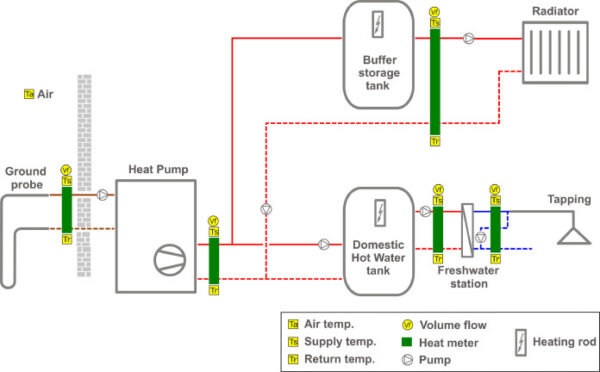How to combine residential heat pumps with PV, battery storage – pv magazine India
New research from Germany’s Fraunhofer Institute for Solar Energy Systems (Fraunhofer ISE) has shown that combining rooftop PV systems with battery storage and heat pumps can improve heat pump efficiency while reducing reliance on grid electricity.
February 2, 2024
Fraunhofer ISE researchers have studied how residential rooftop PV systems could be combined with heat pumps and battery storage.
They assessed the performance of a PV-heat pump-battery system based on a smart-grid (SG) ready control in a single-family house built in 1960 in Freiburg, Germany.
“It was found that the smart control increased the heat pump operation by boosting the set temperatures,” researcher Shubham Baraskar told pv magazine. “The SG-Ready control increased the supply temperature by 4.1 Kelvin for hot water preparation, which then decreased the seasonal performance factor (SPF) by 5.7% from 3.5 to 3.3. Furthermore, for space heating mode the smart control decreased the SPF by 4% from 5.0 to 4.8.”
The SPF is a value similar to the coefficient of performance (COP), with the difference it is calculated over a longer period with varying boundary conditions.
Baraskar and his colleagues explained their findings in “Analysis of the performance and operation of a photovoltaic-battery heat pump system based on field measurement data,” which was recently published in Solar Energy Advances. They said the main advantage of PV-heat pump systems consists of their reduced grid consumption and lower electricity costs.
The heat pump system is a 13.9 kW ground-source heat pump designed with a buffer storage for space heating. It also relies on a storage tank and a freshwater station for producing domestic hot water (DHW). Both storage units are equipped with electric auxiliary heaters.
The PV system is south-oriented and has a tilt angle of 30 degrees. It has a power ouput of 12.3 kW and a module area of 60 square meters. The battery is DC-coupled and has a capacity of 11.7 kWh. The selected house has a heated living space of 256 m2 and an annual heating demand of 84.3 kWh/m²a.
“The DC power from PV and battery units is converted to AC via an inverter which has a maximum AC power of 12 kW and a European efficiency of 95 %,” the researchers explained, noting that the SG-ready control is able to interact with the electricity grid and adjust the system’s operation correspondingly. “During the periods of high grid load, the grid operator can turn off the heat pump operation to reduce the grid strain or can also undergo a forced turn on in the opposite case.”
Under the proposed system configuration, PV power must be initially used for the house loads, with surplus being supplied to the battery. Excess power could only be exported to the grid, if no electricity is required by the household and the battery is completely charged. If both the PV system and the battery are not able to cover the house’s energy demand, the electricity grid can be used.
“The SG-Ready mode is activated when the battery is fully charged or is charging at its maximum power and there is still PV surplus available,” the academics said. “Conversely, the trigger-off condition is met when the instantaneous PV power remains lower than the total building demand for at least 10 minutes.”
Their analysis considered self-consumption levels, solar fraction, heat pump efficiency, and the impact of the PV system and the battery on the heat pump performance efficiency. They used high-resolution 1-minute data from January to December 2022 and found that the SG-Ready control increased the heat pump supply temperatures by 4.1 K for DHW. They also ascertained that system achieved an overall self-consumption of 42.9% during the year, which translates into financial benefits for the homeowners.
“The electricity demand for the [heat pump] was covered by 36% with the PV/battery system, through 51% in domestic hot water mode and 28% in space heating mode,” the research team explained, adding that higher sink temperatures reduced heat pump efficiency by 5.7% in DHW mode and by 4.0% in space heating mode.
“For space heating, a negative effect of the smart control was also found,” Baraskar said. “Due to the SG-Ready control the heat pump operated in space heating above the heating set point temperatures. This was because the control probably increased the storage set temperature and operated the heat pump even though the heat was not needed for space heating. It should also be considered that excessive high storage temperatures can lead to higher storage heat losses.”
The scientists said they will investigate additional PV/heat pump combinations with different system and control concepts in the future.
“It must be noted that these findings are specific for the individual evaluated systems and can vary greatly depending on the building and energy system specifications,” they concluded.
This content is protected by copyright and may not be reused. If you want to cooperate with us and would like to reuse some of our content, please contact: ed*****@pv*********.com.


